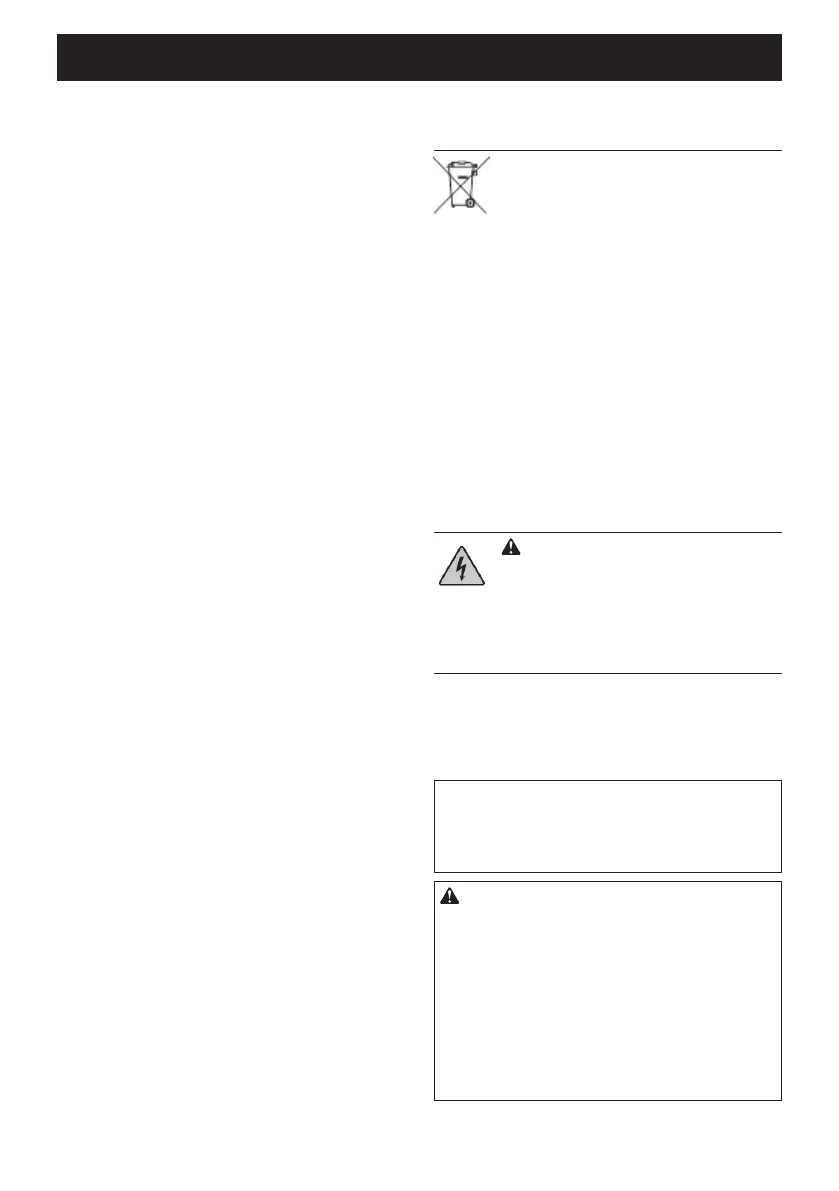Makita DTC303 handleiding
Handleiding
Je bekijkt pagina 4 van 144

4
ENGLISH
Precautions in using cordless crimper
• When using this tool, follow the instructions as shown below:
Precautions for the tool
• Never operate the tool while the head is pointing in the
direction of bystanders.
• When the tool has been stored for extended period at
the temperature of 0°C or less, leave it at a temperature
of 10°C to 15°C for approximately 60 minutes. This is to
ensure the smooth ow of hydraulic oil and also correct
operation of the tool.
• Do not drop the tool or expose it to sudden shocks. This
tool contains many small components and precision
parts. The tool will not operate correctly if exposed to
sudden shocks.
• Do not expose the tool to water, oil or solvents.
• Never operate the tool without dies and a connector
in place.
• Always point the tool away from other people.
• Do not drop the tool. Dropping the tool may damage
the hydraulic circuit and result in the tool not functioning
correctly.
• Keep the head and ram clean and free of debris.
Solvents can be used to clean the head, but should
not be used on the plastic body. Use soap and water
to clean the body.
Precautions in using the battery pack
• Never short-circuit the terminals.
• Keep the battery pack away from water, oil or organic
solvents.
• Do not disassemble or modify the battery pack.
• If the battery pack is disposed of, do not subject it to
ames or dispose of it as general waste. (We promote
recycling.) (see page 9)
• Do not throw or drop the battery pack.
• Do not leave the battery pack in a place where the
temperature is 40°C or higher for a long time.
• Do not short-circuit the battery by placing dirt or dust
on the terminal, as this will lead to malfunction. If the
terminal is corroded, do not use the battery pack.
• A protective function that stops the output is equipped
to prolong the life of the battery pack. The motor may
stop when the remaining battery level is low even
while the operation switch is pressed during the use
of this tool. However, this phenomenon is caused not
by malfunction but by the protective function. In such a
case, immediately charge the battery.
Precautions for the battery charger
• This battery charger has an indicator lamp (multi-
colored LED) to show the battery charging state.
• Do not short-circuit the charger by placing dirt or dust
into the insertion slot, as this will lead to malfunction. If
the metal terminal is corroded, do not use the battery
charger.
Symbols
Only for EU countries
Due to the presence of hazardous
components in the equipment, waste
electrical and electronic equipment,
accumulators and batteries may have a
negative impact on the environment and
human health.
Do not dispose of electrical and electronic
appliances or batteries with household
waste!
In accordance with the European Directive
on waste electrical and electronic equipment
and on accumulators and batteries and
waste accumulators and batteries, as
well as their adaptation to national law,
waste electrical equipment, batteries and
accumulators should be stored separately
and delivered to a separate collection point
for municipal waste, operating in accordance
with regulations on environmental protection.
This is indicated by the symbol of a crossed-
out wheeled bin placed on the equipment.
WARNING: To reduce the risk of arc
ash, electric shock and property damage,
work on deenergized lines when possible.
The tool is not insulated. Should work on
energized lines be required, ensure that
all proper precautions, including those
contained in NFPA 70E, have been taken
rst.
Noise
The typical A-weighted noise level determined according
to EN62841-1:
Sound Pressure level (K=3 dB(A)): 61.9 dB(A)
Sound Power level (K=3 dB(A)): 73.1 dB(A)
NOTE: The declared noise emission value(s) has been
measured in accordance with a standard test method
and may be used for comparing one tool with another.
NOTE: The declared noise emission value(s) may also
be used in a preliminary assessment of exposure.
WARNING:
• Wear ear protection.
• The noise emission during actual use of the
power tool can dier from the declared value(s)
depending on the ways in which the tool is used,
especially what kind of workpiece is processed.
• Be sure to identify safety measures to protect
the operator that are based on an estimation of
exposure in the actual conditions of use (taking
into account of all parts of the operating cycle
such as the times when the tool is switched o
and when it is running idle in addition to the
trigger time).
Bekijk gratis de handleiding van Makita DTC303, stel vragen en lees de antwoorden op veelvoorkomende problemen, of gebruik onze assistent om sneller informatie in de handleiding te vinden of uitleg te krijgen over specifieke functies.
Productinformatie
| Merk | Makita |
| Model | DTC303 |
| Categorie | Niet gecategoriseerd |
| Taal | Nederlands |
| Grootte | 20506 MB |







